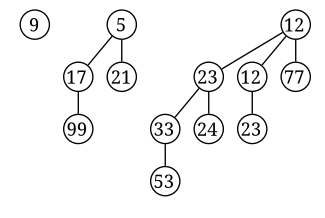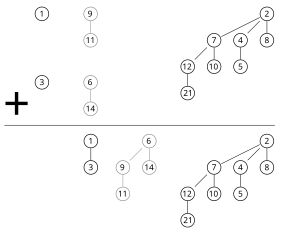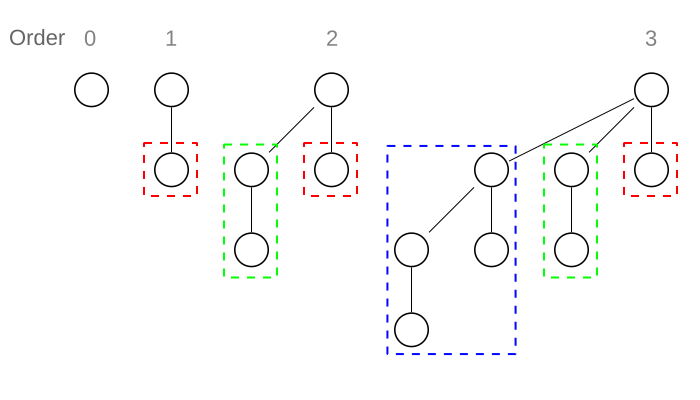Following up on the post on binomial trees, here’s an overview of binomial heaps and the mechanisms behind their various operations.
Structure
A binomial heap is merely a collection of binomial trees, each of which satisfy the heap invariant, having either 0 or 1 tree for each order  . A typical way to represent this is collection is a linked list where the
. A typical way to represent this is collection is a linked list where the  th node has as its value either null or a binomial tree of order
th node has as its value either null or a binomial tree of order  .
.
Recall that a binomial tree of order  has exactly
has exactly  nodes and depth
nodes and depth  . This results in a direct analogy between the representation of a number
. This results in a direct analogy between the representation of a number  in binary and the structure of the binomial heap with
in binary and the structure of the binomial heap with  nodes. For instance, the number 13 has the unique binary representation 1101. This means that the binomial heap with 13 nodes is uniquely determined to have 1 binomial tree each of orders 0, 2, and 3. (
nodes. For instance, the number 13 has the unique binary representation 1101. This means that the binomial heap with 13 nodes is uniquely determined to have 1 binomial tree each of orders 0, 2, and 3. ( .) An example of such a heap is shown below (minus the linked list pointers):
.) An example of such a heap is shown below (minus the linked list pointers):

Source: https://en.wikipedia.org/wiki/Binomial_heap
Note that this also implies that a heap with  nodes with be represented by
nodes with be represented by  trees.
trees.
Operations
Merge
The  operation of merging two binomial heaps is not only their main advantage over traditional binary heaps, but is essential to how most other operations are accomplished.
operation of merging two binomial heaps is not only their main advantage over traditional binary heaps, but is essential to how most other operations are accomplished.
The crucial aspect of how the merge operation works is that merging two binomial trees of order  , each being heaps, takes
, each being heaps, takes  time. You can simply add the one with a larger root value as a child of the other to get a valid tree-heap of order
time. You can simply add the one with a larger root value as a child of the other to get a valid tree-heap of order  . This is illustrated below with two trees of order 2:
. This is illustrated below with two trees of order 2:

Source: https://en.wikipedia.org/wiki/Binomial_heap
Because of this, one can merge 2 binomial heaps with  elements in
elements in  time, following essentially the same procedure as adding 2 binary numbers (keeping track of a ‘carry’ tree, analogous to a carry digit). The figure below illustrates the merging of two binomial heaps with 11 and 3 elements, respectively.
time, following essentially the same procedure as adding 2 binary numbers (keeping track of a ‘carry’ tree, analogous to a carry digit). The figure below illustrates the merging of two binomial heaps with 11 and 3 elements, respectively.

Source: https://en.wikipedia.org/wiki/Binomial_heap
The analogous binary addition would be adding the numbers 1011 and 0011 to get 1110.
Insert
Insertion of a new element into a heap can be simply accomplished by creating a new heap with just the one tree/element and merging it with the original. This takes  time for a single operation, but amortized
time for a single operation, but amortized  time when taken over the course of
time when taken over the course of  consecutive insertions. (Think of the time to increment a binary number by 1
consecutive insertions. (Think of the time to increment a binary number by 1  times.)
times.)
Find Min (Peek)
Since there are at most  trees in a heap with
trees in a heap with  nodes, finding the min by just iterating over the trees takes
nodes, finding the min by just iterating over the trees takes  time. This is the main disadvantage to a binary heap.
time. This is the main disadvantage to a binary heap.
Remove Min (Pop)
However, removing the minimum element takes  time, just as with a binary heap. Having found the tree with the min as its root, you can split up its children into a separate binomial heap and simply merge this with the original.
time, just as with a binary heap. Having found the tree with the min as its root, you can split up its children into a separate binomial heap and simply merge this with the original.
Set Priority
Setting/modifying the value of an element takes  time, since you just float it up or sink it down its tree as you would with an ordinary heap, and each tree has depth
time, since you just float it up or sink it down its tree as you would with an ordinary heap, and each tree has depth  . However, this assumes you have a pointer to where the element is stored.
. However, this assumes you have a pointer to where the element is stored.
Delete Element
To delete an element (again assuming you know where it is), you can simply set its priority to  and remove the min from the heap.
and remove the min from the heap.



